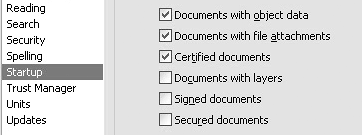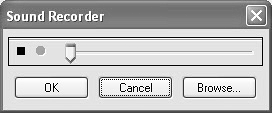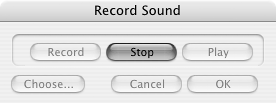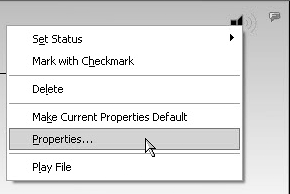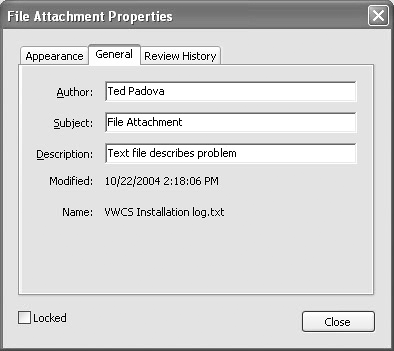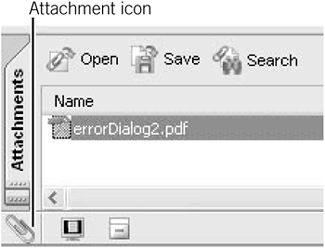When it comes to file attachments, Adobe Reader is far more than just a program for viewing and navigating files. File attachments enable you to use Adobe Reader as your personal briefcase containing any kind of electronic file you can save to your hard drive.
The Commenting toolbar contains two tools you can use for attaching files. Use the Record Audio Comment tool to record an audio message as a comment. Use the Attach a File as a Comment tool to attach any kind of file to a PDF document. When an Acrobat Standard or Professional user attaches files to PDF documents, you can then extract the files from within Adobe Reader with or without Adobe Reader usage rights.
PDF authors can also secure the PDFs with password security. The PDF document acts as a wrapper to transport files between you and other users. If a user does not have the password to open that PDF document, the attached files are not accessible. This is a valuable feature when you need to receive sensitive data. Although you cannot secure a PDF document with password protection, you can open files secured by PDF authors when you have the necessary password to open the file.
A PDF author can attach PDFs as well as other file types to PDF documents. When you open a PDF file in Adobe Reader, you can extract the file attachment—the document needn't have usage rights enabled for you to do so.
Even though you can extract files from PDF documents, Adobe Reader users have only one method for attaching files. When a document has been enabled with usage rights for Adobe Reader, you can you attach a file as a comment.
Note
If you don't have a file that contains a file attachment, use the draftLayout.pdf file from www.peachpit.com/adobereader7.
To extract files from PDF documents:
If you work with files containing file attachments, you may want to have Adobe Reader notify you of any file attachments in an alert dialog when you open such files. Do this to ensure that you're immediately aware of when an attachment is part of the file. To set up this alert, open the Preferences dialog by pressing Ctrl/Command+K.
Note
PDF authors have an option to save a document with or without the Attachments pane open. If the Attachments pane appears when you open a PDF in Adobe Reader, you know a file attachment is added to the PDF. If the Attachments pane does not open, showing the Document Status dialog is the best way to display an alert that a file is attached.
Click Startup in the left pane. Check the box for Documents with file attachments (Figure 13.1). Click OK.
Open a document containing a file attachment. You should see the Document Status dialog (Figure 13.2) open, informing you that the document has special features. Click Close to resume opening the document.
If the Attachments pane is closed, click the Attachments tab to open the pane.
In the Attachments pane (Figure 13.3) are Open, Save, and Search tools. To open an attachment, click the Open tool. To extract the attachment from the PDF and save it as a separate file, click Save. If you have PDF files attached to the document, you can search the PDF attachment content by clicking the Search tool.
Note
In the draftLayout.pdf document, the attached file is an RTF (Rich Text Format) file saved from Microsoft Word. To open the file you need to have an authoring program capable of opening RTF files. But if the document is a Word (.doc) file, you need to have Word installed on your computer. Although you can save files to your hard disk from the Attachments pane, you can open files only when you have the authoring program installed that created the attachments.
Select the file attachment and click the Open tool in the Attachments pane to open the file. A warning dialog (Figure 13.4) opens informing you that the attached file could potentially carry a virus. Click OK when you receive files from reliable sources and you know that the files are virus free.
If you have Microsoft Word installed, the attachment opens in Word. If you don't have a program capable of reading RTF files or any other file type you attempt to open, a warning dialog appears informing you that the file can't be opened. In Figure 13.5, I attempted to open an InDesign CS file on a computer where InDesign CS was not installed.
If you have difficulty opening a file attachment, click the Save tool and save the file to your hard disk. Then open an authoring application that can import the file if possible.
The Record Audio Comment tool has two purposes. Using the tool enables you to 1) record (or import) a sound, and 2) attach the sound to a PDF. To record a sound you must have a microphone attached to your computer. In addition to recordings made in Adobe Reader, you can import sound files from your hard disk. The sound is then embedded as an attachment. Audio comments are available only when you're working with files enabled with usage rights.
Note
To record and import sound files, you can use any PDF document enabled with Adobe Reader usage rights. Use the eSupport.pdf file, located at www.peachpit.com/adobereader7, to play an audio comment.
To add and play sound files:
Open a file enabled with Adobe Reader usage rights.
Click the Record Audio Comment tool (Figure 13.6).
Click on a document page. The Sound Recorder dialog (Windows shown in Figure 13.7) or the Record Sound dialog (Macintosh shown in Figure 13.8) opens.
Be certain your microphone is attached to your computer and working properly. Click the red circle (Windows) or Record button (Macintosh) to begin recording.
Click OK (Windows) or Stop (Macintosh) to end the recording.
Select the Hand tool and open a context menu on the comment icon. Select Properties (Figure 13.9).
Click General in the Sound Attachment Properties dialog. This dialog shows you the file size for the recording. Check the file size to be certain it's not too large for your use. File size is only limited by the amount of available hard disk space.
Click Close in the Sound Attachment Properties dialog and save the file.
To play the file, double-click the Comment icon with the Hand tool.
Attaching files is handled by the Attach a File as a Comment tool. You can attach any kind of document file to a PDF file. To use the Attach a File as a Comment tool, you need to open an Adobe Reader file enabled with usage rights.
To attach files to a PDF document:
Open a document enabled with usage rights for Adobe Reader.
On the Commenting toolbar, click the Attach a File as a Comment tool (Figure 13.10).
Click on a document page where you want the Comment icon to appear. The Add Attachment dialog opens. Navigate your hard drive to locate a file.
Select the file to attach to the PDF, and click the Select button in the Add Attachment dialog. The file is attached and the File Attachment Properties dialog opens (Figure 13.11).
Click General and type a description of the file attachment in the Description field. Click Close to exit the dialog.
Click the Attachments tab to open the Attachments pane.
At the lower left and below the Attachments pane (Figure 13.12), you can see an Attachment icon. If you click the icon, the Document Status dialog opens. Notice the file attachment is listed in the tab.
Save the file.
The PDF file is ready to send to your recipients. When you email the PDF document, the embedded file attachment travels with the host PDF file.

